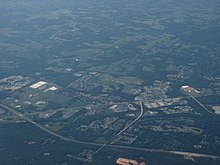

An exurb (or alternately: exurban area) is an area outside the typically denser inner suburban area, at the edge of a metropolitan area, which has some economic and commuting connection to the metro area, low housing density, and growth. It shapes an interface between urban and rural landscapes holding a limited urban nature for its functional, economic, and social interaction with the urban center, due to its dominant residential character.[1] Exurbs consist of "agglomerations of housing and jobs outside the municipal boundaries of a primary city"[2] and beyond the surrounding suburbs.[3]
- ^ Fra Paleo, Urbano (2004). "Exurbia". In Caves, R. W. (ed.). Encyclopedia of the City. Routledge. p. 254.
- ^ Shirgaokar, M (2014). "Employment centers and travel behavior: exploring the work commute of Mumbai's rapidly motorizing middle class". Journal of Transport Geography. 41: 249–258. doi:10.1016/j.jtrangeo.2014.10.003. "Here the term exurb is taken from the North American planning literature, and is used to designate agglomerations of housing and jobs outside the municipal boundaries of a primary city. Such exurbs may have independent municipal governance."
- ^ Duffy, A (2009). "Land use planning in Ireland – a life cycle energy analysis of recent residential development in the Greater Dublin Area". The International Journal of Life Cycle Assessment. 14 (3): 268–277. doi:10.1007/s11367-009-0059-7. S2CID 56212626. "The GDA was split into four zones each encompassing development at increasing radii from Dublin's city centre, namely: city centre, suburbs, exurbs and commuter towns."
© MMXXIII Rich X Search. We shall prevail. All rights reserved. Rich X Search
